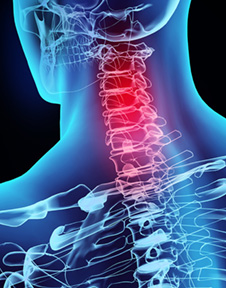By Scott Bradley, MD, Hampton Roads Orthopaedics & Sports Medicine
 Although cervical whiplash is a common injury, the condition is often misdiagnosed and overlooked in patients who might suffer frustrating or debilitating symptoms for months or years.
Although cervical whiplash is a common injury, the condition is often misdiagnosed and overlooked in patients who might suffer frustrating or debilitating symptoms for months or years.
With specialized training, advanced diagnostic equipment and tailored therapies, we can offer a range of treatment options to erase or ease mild to severe pain.
Whiplash injuries occur with rapid acceleration and deceleration of the head, most often during car accidents. That force can stretch and tear muscles, ligaments and joints between the vertebrae of the neck.
Studies have shown more than 80 percent of people in a car accident sustain some degree of whiplash, while crashes at speeds of as little as five miles per hour can induce a cervical injury. Symptoms can appear weeks or months after an accident.
While mild cases might present with minor neck discomfort and stiffness, moderate to severe cases may include multiple complaints, including headache, dizziness, vision changes, tinnitus and pain or numbness in the neck, shoulder, arm or jaw. Without relief, these patients also are at risk for developing depression, anxiety and insomnia.
Unfortunately, cervical whiplash injuries can be difficult to diagnose because damage to structures in the neck may not appear on imaging tests, and because reported pain may be located away from the neck. By the time many patients reach us, they have consulted with multiple doctors in emergency room and community settings. Frequently, they have received ineffective medication or been told there is nothing physically wrong with them; some have been dismissed as drug-seekers.
By listening closely to clinical symptoms, we often can match pain in a certain area of the body to a specific structure in the neck. In many cases, pain arises from the facet joints, small synovial joints between and behind adjacent vertebrae that provide spinal column stability and allow for proper movement.
Generally, our treatment plans begin with conservative approaches such as anti-inflammatory medications, muscle relaxants and application of heat or ice, along with physical therapy and stretches to loosen and repair shocked muscles. Precise medication management and individualized exercise regimens can relieve many mild cases of whiplash.
For patients with moderate to severe injuries, we can offer advanced diagnostic tests such as nuclear medicine studies and discuss more aggressive therapies. Our goal is to address the source of each person’s pain – not mask it temporarily or rely on a single-angle treatment.
Options include epidural steroid injections or facet joint injections to reduce inflammation. Another promising treatment is radiofrequency ablation (RFA), which burns the nerves that enervate damaged joints. RFA has the potential to block pain for eight to 10 months, giving muscles time to reset and freeing patients to participate fully in physical therapy.
The improvements we see can have a major quality-of-life impact. Many patients greet us with smiles, hugs and joyful stories of finally returning to their regular activities. With patience and persistence, we can find solutions for cervical whiplash.
 Dr. Bradley is Board certified in Physical Medicine and Rehabilitation and specializes in disorders of the spine, musculoskeletal system and acute sports-related injuries. He will join Hampton Roads Orthopaedic & Sports Medicine in February 2017, practicing at the New Town office in Williamsburg. www.hrosm.com.
Dr. Bradley is Board certified in Physical Medicine and Rehabilitation and specializes in disorders of the spine, musculoskeletal system and acute sports-related injuries. He will join Hampton Roads Orthopaedic & Sports Medicine in February 2017, practicing at the New Town office in Williamsburg. www.hrosm.com.

